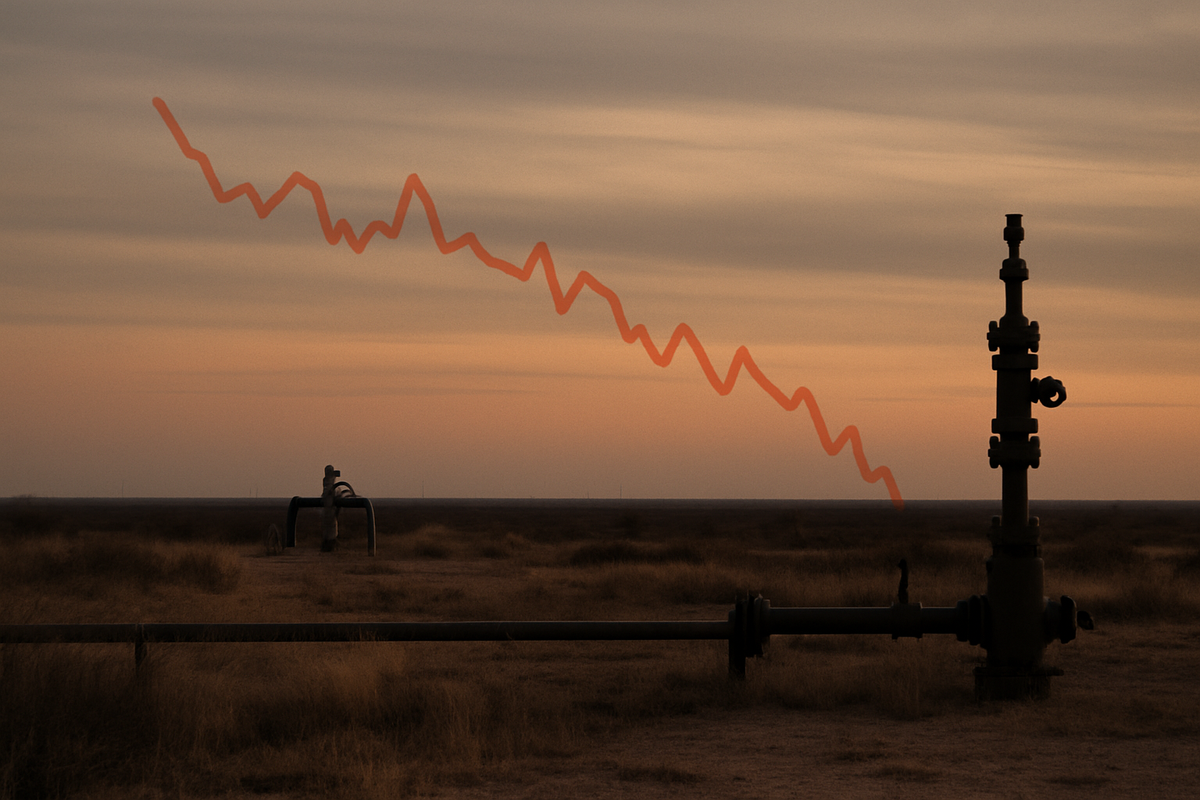
APA Corporation (NASDAQ: APA) has made a significant strategic move, opting to curtail its U.S. natural gas and Natural Gas Liquids (NGL) output in the third quarter of 2024. This decision, driven primarily by persistently weak commodity prices, particularly the "weak or negative Waha hub prices" for natural gas in the Permian Basin, signals a proactive approach by the energy giant to navigate challenging market conditions. The move underscores the profound impact that volatile energy prices can have on production strategies and the broader financial health of major players in the oil and gas sector.
The curtailments, which exceeded the company's own guidance for Q3, highlight the ongoing pressures faced by producers in regions where natural gas prices have hit multi-year lows. This strategic adjustment by APA Corp. reflects a broader industry trend where companies are increasingly prioritizing profitability and capital discipline over maximizing volume in an unfavorable pricing environment.
Strategic Curtailments Reflect Market Realities
During the third quarter of 2024, APA Corp. significantly reduced its U.S. natural gas production by approximately 103 million cubic feet per day (MMcf/d). Concurrently, NGL output saw a reduction of about 10,000 barrels per day (bpd). These cuts were more substantial than the company's initial guidance, which had projected curtailments of around 90 MMcf/d for natural gas and 7,500 bpd for NGLs. The primary catalyst for these aggressive reductions was the sustained weakness in U.S. natural gas prices, with the Waha hub in West Texas experiencing negative pricing a record number of times throughout 2024.
APA Corp. had been systematically curtailing production throughout fiscal year 2024, responding to the ongoing softness in natural gas prices. This latest announcement solidifies the company's commitment to adapting its operations to market realities rather than producing at a loss. Despite these significant curtailments, APA Corp. reported robust third-quarter results, with overall reported production reaching 467,000 barrels of oil equivalent (BOE) per day. The company's adjusted production, excluding certain interests, even surpassed guidance by approximately 2%, demonstrating strength in other operational areas.
The company's financial resilience was further evidenced by an increase in cash flow from operations and free cash flow compared to the second quarter, even in the face of lower commodity prices. This positive financial performance was attributed to strategic factors, including substantial free cash flow generated from U.S. third-party gas trading activities and a favorable gas supply contract with Cheniere (NYSE: LNG). In a separate but related development, APA Corp. also announced an agreement in September to divest non-core assets in the Permian Basin for $950 million, a move expected to close in Q4 2024, further streamlining its Permian operations.
Adding to the positive news flow, subsequent to the third quarter, APA Corp. received a credit rating upgrade to BBB- from Standard & Poor's, achieving investment-grade status across all three major rating agencies. Looking ahead, for the fourth quarter of 2024, APA anticipates that total BOE production will be the highest of the year, despite continued curtailments in the Permian Basin due to persistent regional natural gas price weakness. This suggests a strategic reallocation of resources and a focus on more profitable production streams.
Market Winners and Losers from Production Shifts
APA Corp.'s strategic decision to cut natural gas and NGL output will undoubtedly have ripple effects across the energy sector. Companies heavily reliant on Permian Basin natural gas supply, particularly those with exposure to the Waha hub, might face increased price volatility or supply disruptions if other producers follow suit. Conversely, companies with diversified portfolios or those focused on oil production, which has seen more stable pricing, might find themselves in a relatively stronger position. Midstream companies (e.g., pipeline operators like Kinder Morgan (NYSE: KMI) or Energy Transfer (NYSE: ET)) operating in the Permian could see reduced throughput volumes for natural gas, impacting their revenues, although NGL pipeline demand might remain strong depending on processing and export capabilities.
On the other hand, competitors who have less exposure to the low-priced Permian natural gas market, or those with stronger hedging strategies, could potentially gain market share or see improved profitability if the overall supply tightens. Integrated energy companies with significant refining and petrochemical operations might benefit from lower natural gas feedstock costs, provided they can secure consistent supply. Service providers to the natural gas drilling sector in the Permian might experience reduced demand for their services, whereas those supporting oil production or other basins could see sustained activity.
For APA Corp. itself, this move is a calculated win. By reducing exposure to unprofitable natural gas production, the company is safeguarding its cash flow and profitability. The announced asset divestiture further strengthens its balance sheet and focuses its Permian footprint on more lucrative assets. The credit rating upgrade is a testament to the market's positive reception of these strategic decisions, signaling improved financial health and reduced borrowing costs in the long run. This disciplined approach positions APA Corp. to weather market downturns more effectively and allocate capital to higher-return projects.
Broader Industry Implications and Trends
APA Corp.'s curtailment decision is not an isolated event but rather a clear indicator of broader industry trends emphasizing capital discipline and responsiveness to market signals. The persistent weakness in natural gas prices, particularly in regional hubs like Waha, underscores a fundamental imbalance between supply and demand, exacerbated by infrastructure constraints and a mild winter in early 2024. This situation highlights the challenges of monetizing associated gas production from oil-focused drilling, especially when takeaway capacity is insufficient or export opportunities are limited.
The move by a major player like APA Corp. could set a precedent for other producers facing similar economic pressures. If more companies opt for significant curtailments, it could eventually lead to a rebalancing of the natural gas market, potentially supporting prices in the long term. However, in the short term, it reflects the ongoing struggle of the U.S. natural gas industry to manage abundant supply. This situation also has regulatory implications, as policymakers might face renewed calls for investments in natural gas infrastructure, including pipelines and LNG export terminals, to alleviate regional price disparities and enhance market liquidity.
Historically, the energy sector has been cyclical, with periods of oversupply leading to price crashes and subsequent production adjustments. The current scenario mirrors past instances where producers have had to make tough decisions to cut output to preserve value. This event also underscores the increasing sophistication of energy companies in utilizing financial instruments and strategic asset management (like the Permian divestiture) to optimize their portfolios in volatile markets. The focus on free cash flow generation, even with lower commodity prices, marks a shift from the growth-at-all-costs mentality of previous cycles.
The Road Ahead: Short-Term and Long-Term Outlook
In the short term, the market will closely watch for signs of further production adjustments from other Permian natural gas producers. If APA Corp.'s strategic pivot proves successful in bolstering profitability and cash flow, it could encourage competitors to adopt similar strategies, potentially leading to a more widespread tightening of natural gas supply in the region. Investors will also be keen to observe the successful completion of APA Corp.'s Permian asset divestiture and how the proceeds are utilized, whether for debt reduction, share buybacks, or reinvestment in higher-return projects.
Longer term, the natural gas market's trajectory will depend heavily on several factors: the severity of the upcoming winter, the pace of new LNG export capacity coming online (e.g., Golden Pass LNG, Plaquemines LNG), and the overall economic growth influencing industrial demand. Strategic pivots for energy companies may involve further portfolio optimization, increased focus on international assets (where APA Corp. also has significant operations), or a greater emphasis on renewable energy ventures to diversify revenue streams. The continuous pursuit of operational efficiencies and cost reductions will also remain paramount.
Market opportunities could emerge for companies that can efficiently transport natural gas from oversupplied regions to demand centers or export terminals. Challenges will persist for producers with high operating costs or limited access to markets. Potential scenarios range from a gradual recovery in natural gas prices driven by increased demand and tighter supply, to a prolonged period of low prices if new infrastructure development lags or demand growth falters. Companies with strong balance sheets and flexible capital allocation strategies will be best positioned to navigate these evolving market dynamics.
Concluding Thoughts and Investor Watchpoints
APA Corp.'s decision to significantly curtail U.S. natural gas and NGL output in Q3 2024 serves as a potent reminder of the inherent volatility and cyclical nature of commodity markets. The company's proactive stance in responding to "weak or negative Waha hub prices" demonstrates a commitment to financial discipline and shareholder value preservation over unbridled production growth. Key takeaways include the critical importance of market-responsive production strategies, the ongoing challenges posed by regional price disparities in natural gas, and the resilience of well-managed energy companies to generate cash flow even in adverse conditions.
Moving forward, the market will continue to scrutinize natural gas supply-demand fundamentals, particularly the interplay between Permian production, takeaway capacity, and LNG export growth. Investors should watch for further consolidation in the energy sector, strategic asset sales, and the capital allocation decisions of major producers. The long-term outlook for natural gas will be shaped by global energy demand, geopolitical developments, and the pace of the energy transition.
This event underscores that while the U.S. remains a prolific energy producer, profitability dictates production levels. For investors, monitoring the strategic responses of companies like APA Corp. to market signals will be crucial in identifying resilient players poised for long-term success in an ever-evolving energy landscape. The focus on free cash flow, strategic divestitures, and balance sheet strength will likely remain key indicators of a company's ability to thrive.
This content is intended for informational purposes only and is not financial advice






